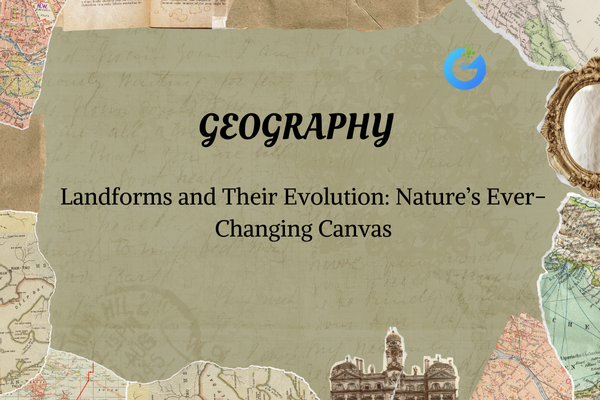Introduction
Have you ever stood in front of a mountain or gazed across a wide open plain and wondered how it came to be? The Earth’s surface, which may seem still and solid, is constantly being reshaped by natural forces. These transformations are not always fast or visible—but over thousands or millions of years, they give rise to the landforms we see around us.
Landforms and their evolution is a key topic in geography. It helps explain not only how Earth looks but also how it behaves, how it changes over time, and how humans interact with it. From the rise of mountain ranges to the quiet erosion of hills, Earth is always changing—and that story is written in its landforms.
expert-led Geography classes – visit our website to learn more
What Are Landforms?
Landforms are natural physical features found on the Earth’s surface. These features vary in size, shape, and height. Some landforms are huge and dramatic—like mountain ranges—while others are broad and flat, like river plains.
Major Types of Landforms:
- Mountains – High, steep, and rugged land rising above surrounding areas.
- Hills – Smaller and more rounded than mountains, often found in groups.
- Plateaus – Elevated flatlands that rise sharply from the surrounding area.
- Plains – Broad, flat, or gently rolling areas of land, often fertile.
- Valleys – Low areas between hills or mountains, often carved by rivers or glaciers.
These landforms are not just natural decorations—they influence climate, human settlement, agriculture, and transportation.
Internal Forces: Building the Land from Within
The surface of the Earth may look solid, but beneath it lies a dynamic system of moving rock plates called tectonic plates. These massive plates shift very slowly over time, but their movement causes big changes.
Key Internal Forces:
1. Folding
- When two plates push against each other, the land between them bends and folds.
- Over time, this creates folded mountain ranges like the Himalayas.
2. Faulting
- Sometimes rocks crack and slide past each other instead of bending.
- This leads to the formation of features like rift valleys, fault lines, and block mountains.
3. Volcanic Activity
- Deep inside the Earth, molten rock called magma can rise to the surface.
- When this happens, it forms volcanoes, lava plateaus, and sometimes even new islands.
These internal processes are often slow, but they can also be sudden and powerful during earthquakes or volcanic eruptions.
External Forces: Shaping the Surface from the Outside
While internal forces create landforms, external forces reshape them. These forces come from nature’s daily activity—wind, water, ice, and temperature changes.
Main External Forces:
1. Weathering
- The process of breaking down rocks into smaller pieces.
- Caused by wind, rain, temperature changes, and chemical reactions.
2. Erosion
- The wearing away and movement of rock and soil by water, ice, wind, and gravity.
- Rivers, glaciers, ocean waves, and wind are common agents of erosion.
3. Deposition
- The process of dropping or laying down material carried by erosion.
- Creates new landforms like deltas, sand dunes, and beaches.
Over time, these processes smooth out mountains, widen valleys, and form new flatlands.
The Life Cycle of Landforms
Just like living things, landforms go through a natural cycle. They are formed, changed, and eventually worn down.
Mountains
- Youthful Stage: High peaks, steep slopes, and deep valleys.
- Mature Stage: Erosion smooths the peaks, valleys widen.
- Old Age: Mountains become worn-down hills or plateaus.
Plains
- Formed by river deposits over time.
- Often rich in nutrients, making them ideal for farming.
Valleys
- Formed by the cutting action of rivers (V-shaped valleys) or glaciers (U-shaped valleys).
Plateaus
- Raised flatlands formed by volcanic activity or tectonic uplift.
- Over time, rivers may cut deep gorges or canyons through them.
How Landforms Affect Human Life
Landforms aren’t just physical features—they have a direct impact on how people live.
Key Influences:
- Settlements: People prefer flat plains and valleys where construction is easier.
- Farming: Fertile plains are great for agriculture; hilly areas use terrace farming.
- Transport: Roads and railways are built more easily on flat terrain.
- Natural Disasters: Mountains can face landslides and earthquakes; coastal areas may face flooding.
- Tourism and Culture: Many landforms are famous tourist attractions or hold cultural significance.
Humans have also changed landforms through activities like mining, construction, dam building, and urban development.
Core Concepts Table
| Term | Definition |
| Landform | A natural feature on the Earth’s surface like a mountain, plain, or valley. |
| Internal Forces | Forces from inside the Earth—like tectonic plate movement and volcanism. |
| External Forces | Surface processes like erosion, weathering, and deposition. |
| Folding | Bending of rock layers due to internal pressure. |
| Faulting | Cracking and shifting of the Earth’s crust. |
| Erosion | Wearing away of land by wind, water, or ice. |
| Deposition | Laying down of eroded materials, forming new landforms. |
| Landform Life Cycle | Natural stages of growth, change, and wearing down of landforms. |
Frequently Asked Questions
Q1. What causes landforms to change over time?
Natural forces like tectonic movements, erosion, weathering, and volcanic activity.
Q2. How are mountains formed?
Through folding of the Earth’s crust when tectonic plates collide, or through volcanic eruptions.
Q3. Why are plains suitable for agriculture?
Plains are flat, have rich soil, and are easier to irrigate and cultivate.
Q4. What are the main agents of erosion?
Rivers, glaciers, wind, and sea waves are the primary agents.
Q5. Can landforms change quickly?
Yes, in events like earthquakes, landslides, or volcanic eruptions, landforms can be altered in minutes.
Fun Facts About Landforms
- The Himalayas are still growing—about 4 millimeters per year.
- Volcanoes under the sea can build up enough to form new islands.
- Mount Everest is the tallest mountain on Earth, but it’s still rising.
- The Grand Canyon was formed by the Colorado River over millions of years.
- Sand dunes in deserts move constantly due to wind erosion.
Conclusion
Landforms are not just static features of geography—they are active parts of Earth’s story, shaped by powerful natural forces. From mountain ranges formed deep underground to valleys carved by flowing rivers, the Earth is constantly evolving. These changes take time, but they are always happening.
By learning about landforms and their evolution, we gain a better understanding of the planet we live on and how it continues to change. It reminds us that nature is a powerful force—and that we must live in harmony with the land beneath our feet.








